Heng Cong
NTIRE 2025 challenge on Text to Image Generation Model Quality Assessment
May 22, 2025Abstract:This paper reports on the NTIRE 2025 challenge on Text to Image (T2I) generation model quality assessment, which will be held in conjunction with the New Trends in Image Restoration and Enhancement Workshop (NTIRE) at CVPR 2025. The aim of this challenge is to address the fine-grained quality assessment of text-to-image generation models. This challenge evaluates text-to-image models from two aspects: image-text alignment and image structural distortion detection, and is divided into the alignment track and the structural track. The alignment track uses the EvalMuse-40K, which contains around 40K AI-Generated Images (AIGIs) generated by 20 popular generative models. The alignment track has a total of 371 registered participants. A total of 1,883 submissions are received in the development phase, and 507 submissions are received in the test phase. Finally, 12 participating teams submitted their models and fact sheets. The structure track uses the EvalMuse-Structure, which contains 10,000 AI-Generated Images (AIGIs) with corresponding structural distortion mask. A total of 211 participants have registered in the structure track. A total of 1155 submissions are received in the development phase, and 487 submissions are received in the test phase. Finally, 8 participating teams submitted their models and fact sheets. Almost all methods have achieved better results than baseline methods, and the winning methods in both tracks have demonstrated superior prediction performance on T2I model quality assessment.
Second FRCSyn-onGoing: Winning Solutions and Post-Challenge Analysis to Improve Face Recognition with Synthetic Data
Dec 02, 2024Abstract:Synthetic data is gaining increasing popularity for face recognition technologies, mainly due to the privacy concerns and challenges associated with obtaining real data, including diverse scenarios, quality, and demographic groups, among others. It also offers some advantages over real data, such as the large amount of data that can be generated or the ability to customize it to adapt to specific problem-solving needs. To effectively use such data, face recognition models should also be specifically designed to exploit synthetic data to its fullest potential. In order to promote the proposal of novel Generative AI methods and synthetic data, and investigate the application of synthetic data to better train face recognition systems, we introduce the 2nd FRCSyn-onGoing challenge, based on the 2nd Face Recognition Challenge in the Era of Synthetic Data (FRCSyn), originally launched at CVPR 2024. This is an ongoing challenge that provides researchers with an accessible platform to benchmark i) the proposal of novel Generative AI methods and synthetic data, and ii) novel face recognition systems that are specifically proposed to take advantage of synthetic data. We focus on exploring the use of synthetic data both individually and in combination with real data to solve current challenges in face recognition such as demographic bias, domain adaptation, and performance constraints in demanding situations, such as age disparities between training and testing, changes in the pose, or occlusions. Very interesting findings are obtained in this second edition, including a direct comparison with the first one, in which synthetic databases were restricted to DCFace and GANDiffFace.
Second Edition FRCSyn Challenge at CVPR 2024: Face Recognition Challenge in the Era of Synthetic Data
Apr 16, 2024



Abstract:Synthetic data is gaining increasing relevance for training machine learning models. This is mainly motivated due to several factors such as the lack of real data and intra-class variability, time and errors produced in manual labeling, and in some cases privacy concerns, among others. This paper presents an overview of the 2nd edition of the Face Recognition Challenge in the Era of Synthetic Data (FRCSyn) organized at CVPR 2024. FRCSyn aims to investigate the use of synthetic data in face recognition to address current technological limitations, including data privacy concerns, demographic biases, generalization to novel scenarios, and performance constraints in challenging situations such as aging, pose variations, and occlusions. Unlike the 1st edition, in which synthetic data from DCFace and GANDiffFace methods was only allowed to train face recognition systems, in this 2nd edition we propose new sub-tasks that allow participants to explore novel face generative methods. The outcomes of the 2nd FRCSyn Challenge, along with the proposed experimental protocol and benchmarking contribute significantly to the application of synthetic data to face recognition.
* arXiv admin note: text overlap with arXiv:2311.10476
NTIRE 2023 Quality Assessment of Video Enhancement Challenge
Jul 19, 2023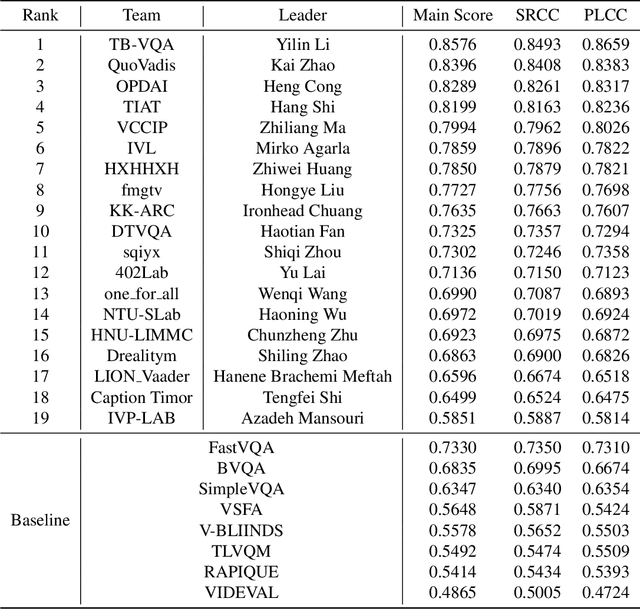
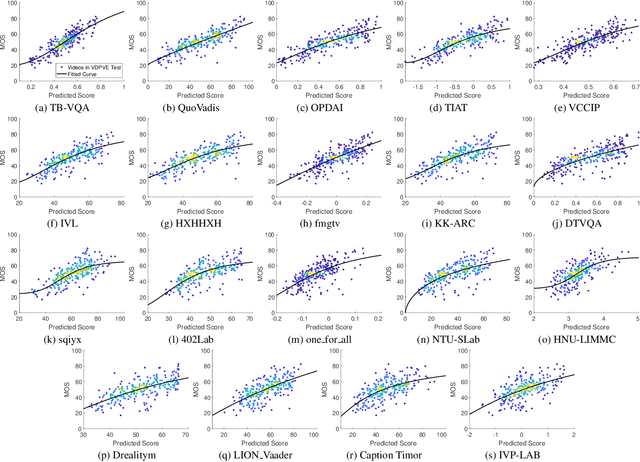


Abstract:This paper reports on the NTIRE 2023 Quality Assessment of Video Enhancement Challenge, which will be held in conjunction with the New Trends in Image Restoration and Enhancement Workshop (NTIRE) at CVPR 2023. This challenge is to address a major challenge in the field of video processing, namely, video quality assessment (VQA) for enhanced videos. The challenge uses the VQA Dataset for Perceptual Video Enhancement (VDPVE), which has a total of 1211 enhanced videos, including 600 videos with color, brightness, and contrast enhancements, 310 videos with deblurring, and 301 deshaked videos. The challenge has a total of 167 registered participants. 61 participating teams submitted their prediction results during the development phase, with a total of 3168 submissions. A total of 176 submissions were submitted by 37 participating teams during the final testing phase. Finally, 19 participating teams submitted their models and fact sheets, and detailed the methods they used. Some methods have achieved better results than baseline methods, and the winning methods have demonstrated superior prediction performance.
The Monocular Depth Estimation Challenge
Nov 22, 2022



Abstract:This paper summarizes the results of the first Monocular Depth Estimation Challenge (MDEC) organized at WACV2023. This challenge evaluated the progress of self-supervised monocular depth estimation on the challenging SYNS-Patches dataset. The challenge was organized on CodaLab and received submissions from 4 valid teams. Participants were provided a devkit containing updated reference implementations for 16 State-of-the-Art algorithms and 4 novel techniques. The threshold for acceptance for novel techniques was to outperform every one of the 16 SotA baselines. All participants outperformed the baseline in traditional metrics such as MAE or AbsRel. However, pointcloud reconstruction metrics were challenging to improve upon. We found predictions were characterized by interpolation artefacts at object boundaries and errors in relative object positioning. We hope this challenge is a valuable contribution to the community and encourage authors to participate in future editions.
Multi-target Tracking of Zebrafish based on Particle Filter
Aug 09, 2022
Abstract:Zebrafish is an excellent model organism, which has been widely used in the fields of biological experiments, drug screening, and swarm intelligence. In recent years, there are a large number of techniques for tracking of zebrafish involved in the study of behaviors, which makes it attack much attention of scientists from many fields. Multi-target tracking of zebrafish is still facing many challenges. The high mobility and uncertainty make it difficult to predict its motion; the similar appearances and texture features make it difficult to establish an appearance model; it is even hard to link the trajectories because of the frequent occlusion. In this paper, we use particle filter to approximate the uncertainty of the motion. Firstly, by analyzing the motion characteristics of zebrafish, we establish an efficient hybrid motion model to predict its positions; then we establish an appearance model based on the predicted positions to predict the postures of every targets, meanwhile weigh the particles by comparing the difference of predicted pose and observation pose ; finally, we get the optimal position of single zebrafish through the weighted position, and use the joint particle filter to process trajectory linking of multiple zebrafish.
* 6 pages, 8 figures, 2016 35th Chinese Control Conference (CCC)
Image Quality Assessment with Gradient Siamese Network
Aug 08, 2022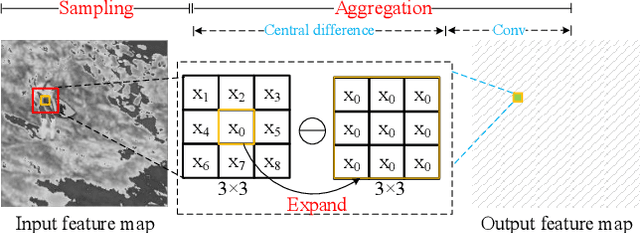
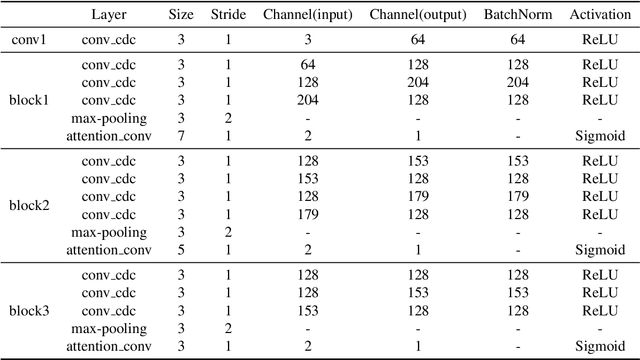


Abstract:In this work, we introduce Gradient Siamese Network (GSN) for image quality assessment. The proposed method is skilled in capturing the gradient features between distorted images and reference images in full-reference image quality assessment(IQA) task. We utilize Central Differential Convolution to obtain both semantic features and detail difference hidden in image pair. Furthermore, spatial attention guides the network to concentrate on regions related to image detail. For the low-level, mid-level and high-level features extracted by the network, we innovatively design a multi-level fusion method to improve the efficiency of feature utilization. In addition to the common mean square error supervision, we further consider the relative distance among batch samples and successfully apply KL divergence loss to the image quality assessment task. We experimented the proposed algorithm GSN on several publicly available datasets and proved its superior performance. Our network won the second place in NTIRE 2022 Perceptual Image Quality Assessment Challenge track 1 Full-Reference.
* 10 pages, 5 figures, Computer Vision and Pattern Recognition (CVPR) Workshops
Multi-Frames Temporal Abnormal Clues Learning Method for Face Anti-Spoofing
Aug 08, 2022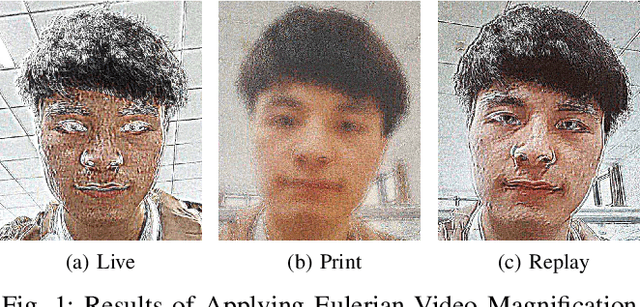
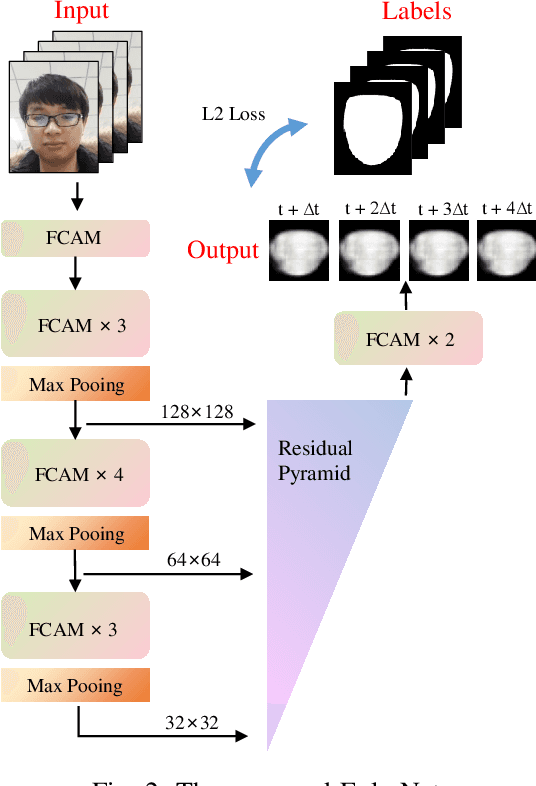

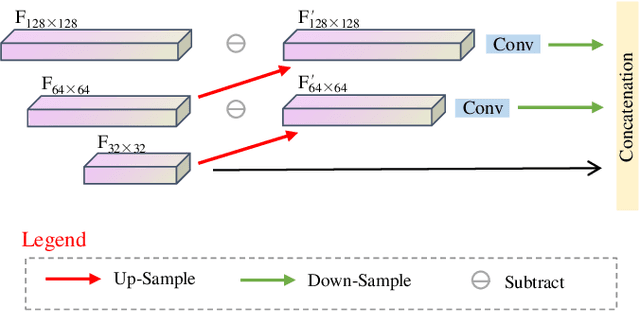
Abstract:Face anti-spoofing researches are widely used in face recognition and has received more attention from industry and academics. In this paper, we propose the EulerNet, a new temporal feature fusion network in which the differential filter and residual pyramid are used to extract and amplify abnormal clues from continuous frames, respectively. A lightweight sample labeling method based on face landmarks is designed to label large-scale samples at a lower cost and has better results than other methods such as 3D camera. Finally, we collect 30,000 live and spoofing samples using various mobile ends to create a dataset that replicates various forms of attacks in a real-world setting. Extensive experiments on public OULU-NPU show that our algorithm is superior to the state of art and our solution has already been deployed in real-world systems servicing millions of users.
 Add to Chrome
Add to Chrome Add to Firefox
Add to Firefox Add to Edge
Add to Edge